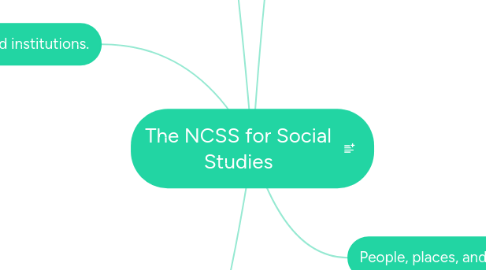
1. Individuals, Groups, and institutions.
1.1. Goal
1.1.1. Studies interactions among individuals, groups, and institutions.
1.2. Major Concepts
1.2.1. Role of the Family
1.2.2. Role of the School
1.2.3. Role of the community
1.2.4. Peer groups
1.3. Art Activities
1.3.1. Create their own neighborhood
1.3.2. Dramatic Play/arrange different types of businesses for community helpers role
1.4. Developmentally Appropriate
1.4.1. Learn more about their culture and heritage
1.4.2. Incorporate an environment that they can recognize and play.
1.4.3. Facilitate areas and material so they can express themselves.
2. Individual Development and identity
2.1. Goal
2.1.1. Teaches about the self, others, the group, family, schools, and community along with the development of social skills
2.2. Major Concepts
2.2.1. * Self-Concept
2.2.2. * Self-efficacy
2.2.3. * Relationships with others
2.2.4. * Cooperation
2.2.5. * Friendship
2.2.6. * Conflict resolution
2.3. Art Activities
2.3.1. Make self-portrait
2.3.2. Dramatic play/dress-up
2.3.3. Singing multicultural songs
2.3.4. Reading Books about "Me"
2.4. Developmentally Appropriate
2.4.1. Work as a team, sharing and solving-problems together in the classroom.
2.4.2. Displaying their pictures during different activities
2.4.3. Displaying their art projects
3. Culture
3.1. Goal
3.1.1. Includes the religious, political, racial, and social traits, and belief of a social group of people that focus on culture and cultural diversity.
3.2. Major Concepts
3.2.1. * Interconnectedness
3.2.2. * Diversity
3.2.3. * Conflict Resolution
3.2.4. * Multiculturalism across the curriculum
3.2.5. * Anti-bias values
3.2.6. * Teaching Peace
3.3. Art Activities
3.3.1. Singing multicultural songs
3.3.2. Displaying family pictures
3.3.3. Photographs of different places, clothing, food, etc.
3.4. Developmentally Appropriate
3.4.1. Invite families to share their culture with food, songs or stories.
3.4.2. Celebrating their heritage as a group.
3.4.3. Teaching about respect and appreciation for other cultures.
4. Time, Continuity and change
4.1. Goal
4.1.1. Includes ways human beings view themselves in and over time.
4.2. Major Concepts
4.2.1. * Time
4.2.2. * Change
4.2.3. * Continuity of human life
4.2.4. The past
4.2.5. Methods of the historian
4.3. Art Activities
4.3.1. Construct and use puppets of historical figures.
4.3.2. Use of fables, folktales, and legends
4.3.3. Seasonal pictures and art projects
4.4. Developmentally Appropriate
4.4.1. Incorporate field trips to the museum
4.4.2. Inviting families to share stories about then and now.
4.4.3. Exploring themes such as dinosaurs, exploring real bones, fossils, etc.
5. People, places, and the environment
5.1. Goal
5.1.1. Addresses population distribution; understanding connections between people and geography
5.2. Major concepts
5.2.1. * The earth is the place we live
5.2.2. * Directions and locations
5.2.3. * Relationships within places
5.2.4. * Regions
5.3. Art Activities
5.3.1. Display pictures of cities, countries, brochures.
5.3.2. Using multicultural pencils or crayons.
5.3.3. Sharing instruments from other culture
5.4. Developmentally appropriate
5.4.1. Providing material according to their age and needs
5.4.2. Incorporating objects, books, pictures that are related to their culture.
